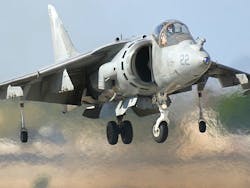Navy looks to Hood Tech to provide non-contact jet engine blade vibration and monitoring
Officials of the Naval Air Warfare Center Weapons Division at China Lake Naval Weapons Station, Calif., have announced their intention to negotiate exclusively with Hood Tech for a one-year contract for AV-8B support.
The AV-8B is a vertical- and short-takeoff fighter-bomber designed to operate from aircraft carriers, amphibious assault ships, and undeveloped land bases.
Related: Jetliner engine maintenance moves to electronic monitoring
Hood Tech is the Navy's sole supplier of in-flight blade vibration and monitoring, and provides unique optical probe and laser sensors, facilities, and testing experience to characterize turbofan engine blade stress, dynamic behavior profiles, and lifecycle failure predictions in the laboratory as well as in flight, Navy officials say.
This capability is unique with no known competition, officials say. The Hood Tech blade vibration monitoring system has been demonstrated in flight with a previous flight test program at China Lake using a VX-31 aircraft with three different LPC1 blade configurations and this equipment is needed to meet flight testing currently scheduled in 2015.
Hood Tech specializes in blade vibration and monitoring (BVM) for rotating machinery like gas turbine engines, turbochargers, steam turbines, and compressors. This discipline measures rotating machinery using sensors that do not make contact with the rotor blades.
Related: Navy looks to Boeing for repair and upgrade of Marine Corps AV-8B Harrier jump jets
A BVM system acquires data for each blade, and is valuable for vibration characterization, risk mitigation, noise abatement, and failure prediction. The AV-8B is particularly noisy when it takes off vertically.
Although Hood Tech is considered to be the only source of this kind of expertise, companies whose officials believe they can match Hood Tech's skills may respond no later than the end of this week, 5 Dec. 2014, to the Navy's Joel Ashworth at [email protected], or Christopher Burchett at [email protected].
More information is online at https://www.fbo.gov/spg/DON/NAVAIR/N68936D1/N6893615R0047/listing.html.
